FOUNDATIONS REVEALED COMPETITION ENTRY

The Araluen Courier
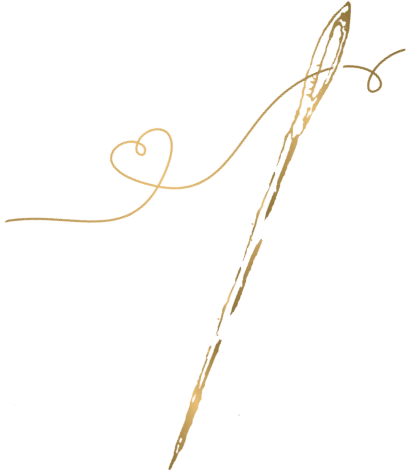
Outline the story …
My entry was inspired by one of my favourite book series to escape into, The Rangers Apprentice by John Flanagan. The series is set in an alternate version of 10th century medieval England. Because of this alternative timeframe, my design, while loosely based on 10th century styles, is not an accurate representation of true 10th century clothing.
I based my design on the character Alyss, who is a Courier, a position in this world that translates to diplomat and spy. She needs to look elegant and well put together, comfortable mingling with high-ranking nobles; however, given she may need to fight for her life or jump onto a horse to either flee a situation or deliver important messages, her clothing needs to move with her. Therefore, I replaced the more traditional underkirtle with a separate blouse and trousers, and split the overkirtle panels, to give her room to move, access concealed weapons, and fight without getting tangled in skirts.
In the book the author hasn’t given detailed descriptions of clothing, the most descriptive being that she wore a ‘beautifully cut white gown’ giving me a lot of room for interpretation. I kept the overdress white, but to bring more dimension into the finished outfit I made the underclothes grey. I chose the Herjolfsnes finds to inspire my overkirtle design, as even though this is from a later time period, I felt it met the ‘beautifully cut’ description better than a more rectangular cut kirtle of the 10th century.
Outline the construction…
The under garments were created from commercial patterns with adjustments. To create the blouse, I used the top of a dress pattern (Burda 7977), removed the back opening, and lengthened and slimmed down the sleeves. For the trousers (Simplicity 5235), I raised the waistline to allow for a drawstring waistband and added extra fabric to either side of the legs to create a skirt-like silhouette. Both these undergarments were machine sewn using French seams with 6mm rolled hems. As it was often used for undergarments at this time, these were constructed in linen.
I created a pattern for the overkirtle using the Herjolfsnes finds as inspiration for the shape and number of bodice pieces. This required lots of tweaking to get the right amount of fabric through the bodice area, as the first mock-ups tended to flatten rather than support the bust and gaped around the waist where I wanted a closer fit. The bodice seams are sewn on machine, however all the finishing of seams, hems and facings are handsewn using a slip stitch. Due to the split nature of the skirt panels, this meant that every seam had to be finished open, unlike the more traditional folded over felled seam. I finished the front closure with hooks and eyes, as the 10th century inspired keyhole neckline wouldn’t allow for such a close fit through the waistline. Finally, to echo the decoration of 10th century clothing, I added a silver trim around the neck and down the front seams.

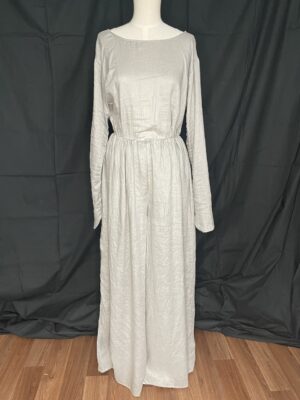
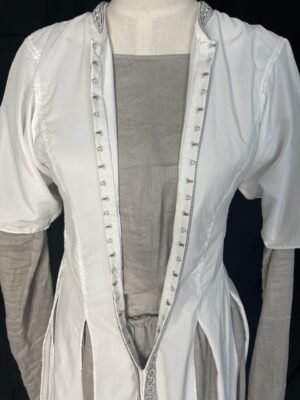
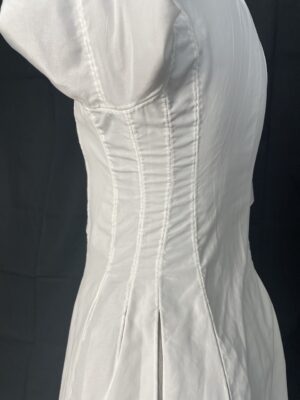
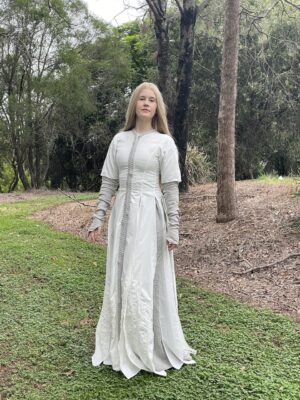
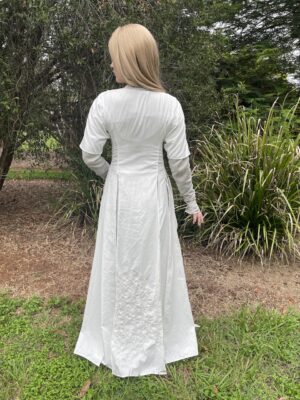

I really like the unsewn skirt panels, it is practical while moving while also being highly elegant. It is a lovely design.
Fabulous design. I adore that it’s fighting appropriate. It’s so elegant yet practical. I’m also very impressed by your high-kick.
I love how dramatic this design is! Lovely fit and construction too!